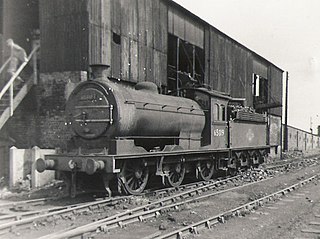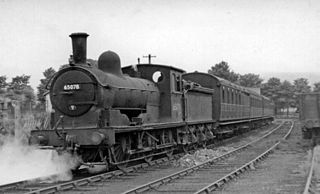The London and North Eastern Railway (LNER) produced several classes of locomotive, mostly to the designs of Nigel Gresley, characterised by a three-cylinder layout with a parallel boiler and round-topped firebox. It produced the most famous locomotive of its day, 4468 'Mallard', the holder of the world steam locomotive speed record. It also built the world-famous 4472 'Flying Scotsman'. However, its locomotive inheritance was much greater than just the 'A4 Class', it also produced highly successful mixed-traffic and freight designs.

The North Eastern Railway (NER) Class P3, classified J27 by the LNER, is a class of 0-6-0 steam locomotive. The P3 Class was designed by Wilson Worsdell and was a relatively minor modification of the existing North Eastern Railway NER Class P2. The most significant change was a deeper firebox with shallower sloping fire grate. This was achieved by raising the boiler slightly, and by reducing the clearance between the firebox and the rear axle. The P3 Class were a freight engine by nature and used for hauling long trains of freight.

North Eastern Railway Class T3, classified Q7 by the LNER is a class of 0-8-0 steam locomotive designed for heavy freight. Five were built by the NER in 1919 and a further 10 by the London and North Eastern Railway (LNER) in 1924.

The North Eastern Railway (NER) Class C1, was a class of 0-6-0 freight locomotives designed by T.W. Worsdell. They were used throughout the NER system, although particularly in Teesside between 1886 and 1962.

The North Eastern Railway Class T2, classified as Class Q6 by the LNER, is a class of 0-8-0 steam locomotive designed for heavy freight, especially for hauling long coal trains to various collieries in the North Eastern region of the UK, with a maximum speed of 40 miles per hour. One-hundred-and-twenty were built at Darlington Works and Armstrong Whitworth between 1913 and 1921 to the design of Vincent Raven, based on the NER Class T and T1. The batch of fifty built by Armstrong Whitworth from 1919 were A-W's first locomotives to be built, after the conversion of their Scotswood works from ordnance to peacetime production.

Class EE1 was an electric locomotive commissioned by the North Eastern Railway in 1922. Ownership passed to the London and North Eastern Railway in 1923 and to British Railways in 1948.

The North Eastern Railway (NER) Class H, classified as Class Y7 by the London and North Eastern Railway (LNER) is a class of 0-4-0T steam locomotives designed for shunting.

The North Eastern Railway Class E1, classified as Class J72 by the London and North Eastern Railway (LNER), is a class of small 0-6-0T steam locomotives designed by Wilson Worsdell for shunting. They had inside cylinders and Stephenson valve gear.

The North Eastern Railway (NER) Class Y 4-6-2T tank locomotives were designed whilst Wilson Worsdell was Chief Mechanical Engineer, but none were built until 1910 by which time Vincent Raven had taken over.
The North Eastern Railway (NER) Class K classified as Class Y8 by the London and North Eastern Railway (LNER) is a class of 0-4-0T steam locomotives designed for shunting. It was designed by Thomas W. Worsdell and five of these tiny engines were built in 1890. These were numbered 559-63.

The NER Class O was a class of 0-4-4T steam locomotives of the North Eastern Railway, designed by the company's Chief Engineer, Wilson Worsdell. They all survived into British Railways ownership in 1948 and their BR numbers were 67240-67349. They were withdrawn between 1950 and 1958.
The NER Class P was a class of 0-6-0 steam locomotives of the North Eastern Railway. They were designed by Wilson Worsdell for mineral traffic.
The NER Class P1 was a class of 0-6-0 steam locomotives of the North Eastern Railway. Class P1 was a development of Class P, having a boiler four inches longer, and a firebox six inches longer. To accommodate these, the wheelbase was increased by nine inches. The cylinder stroke was also increased by two inches. None survived into preservation
The NER Class L was a class of 0-6-0T steam locomotives of the North Eastern Railway. They were a specialised design, intended for use on the Redheugh and Quayside banks on either side of the River Tyne. They were replaced on the Quayside branch by NER Class ES1 electric locomotives in 1905 but were re-allocated to other duties.

The NER Class 290 was a class of 0-6-0T steam locomotives of the North Eastern Railway (NER), rebuilt from an earlier class of 0-4-4T, the NER Bogie Tank Passenger.

The H&BR Class G3 was a class of 0-6-0T steam locomotives of the Hull and Barnsley Railway (H&BR). The H&BR became part of the North Eastern Railway (NER) in 1922 and the NER became part of the London and North Eastern Railway (LNER) in 1923.

The NBR S Class is a class of 0-6-0 steam locomotive designed by William Paton Reid for freight work on the North British Railway. The engines were initially designated as B class, being a development of the standard B class locomotives designed by Reid some eight years previously, and represented the culmination of a long evolution on the NBR of powerful 0-6-0 freight engines. The new locomotives were introduced in 1914 and had superheaters, inside cylinders and piston valves operated by Stephenson valve gear.
West Auckland railway station served the villages of St Helen Auckland and West Auckland in County Durham, England, between 1833 and 1962. It was on the railway line between Bishop Auckland and Barnard Castle. There was a locomotive depot, which was the only one to be both closed completely and later reopened by the London and North Eastern Railway.
The NER Class N was a class of 0-6-2 tank locomotives of the North Eastern Railway. It was designed by Wilson Worsdell and introduced in 1893.
The NER Class U was a class of 0-6-2 tank locomotives of the North Eastern Railway. It was designed by Wilson Worsdell and introduced in 1902.












